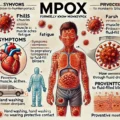The COVID-19 pandemic has dominated global headlines and changed the way we live, work, and interact. However, it is not the only viral disease that has posed a threat to public health. Mpox, formerly known as monkeypox, is another virus that has caused concern, though it has not reached the same global scale as COVID-19. In this blog, we’ll explore the key differences between mpox and coronavirus in terms of recovery rates, available medicines, and their origins. We’ll also discuss how pandemics affect large populations in countries like China and India and provide tips on improving self-immunity without relying on medicines.
Key Differences Between Mpox and Coronavirus
1. Origin and Transmission
- Mpox:
- Origin: Mpox is a zoonotic virus, meaning it is transmitted from animals to humans. It was first discovered in 1958 in monkeys kept for research, which led to its name. However, the primary animal reservoirs are thought to be certain rodents and other small mammals found in Central and West Africa. In 1970, reports of human cases were initially made in the Democratic Republic of the Congo.
- Transmission: Mpox primarily spreads through direct contact with the blood, bodily fluids, or skin lesions of infected animals or humans. It can also spread through respiratory droplets during prolonged face-to-face contact, though this is less common. Additionally, the virus can be transmitted through contaminated materials, such as bedding or clothing.
- Coronavirus (COVID-19):
- Origin: The coronavirus responsible for COVID-19, known as SARS-CoV-2, was first identified in December 2019 in Wuhan, China. It is believed to have originated from bats, with a possible intermediary animal host, though the exact source is still under investigation. The virus is part of a larger family of coronaviruses, some of which cause mild illnesses like the common cold, while others have caused more severe diseases like SARS and MERS.
- Transmission: COVID-19 primarily spreads through respiratory droplets when an infected person coughs, sneezes, talks, or breathes. Though less frequently, it can also spread through contact with contaminated surfaces. The virus is highly contagious, leading to widespread transmission and global outbreaks.
2. Symptoms and Severity
- Mpox Symptoms:
- Smallpox and mpox symptoms are comparable, albeit mpox symptoms are typically milder. The disease typically begins with fever, headache, muscle aches, and swollen lymph nodes.A rash appears within a few days, usually beginning on the face and moving to other areas of the body. The rash progresses from flat lesions to raised bumps, then to fluid-filled blisters, which eventually crust over and fall off.
- The severity of mpox varies, with most cases being mild and self-limiting, lasting 2 to 4 weeks. Severe cases, however, can happen, particularly in young infants, expectant mothers, and those with compromised immune systems.
- COVID-19 Symptoms:
- COVID-19 symptoms range from mild to severe and can vary widely among individuals. Common symptoms include fever, cough, and difficulty breathing, but the virus can also cause fatigue, body aches, loss of taste or smell, sore throat, and gastrointestinal issues like diarrhea. Acute respiratory distress syndrome (ARDS), organ failure, pneumonia, and even death are possible outcomes of severe instances.
- COVID-19 is particularly dangerous for older adults and those with underlying health conditions, such as heart disease, diabetes, or compromised immune systems. The disease has led to millions of deaths worldwide and continues to pose a significant public health challenge.
3. Recovery Rates and Treatment
- Mpox Recovery and Treatment:
- Recovery Rate: The recovery rate for mpox is generally high, with most individuals recovering within 2 to 4 weeks without the need for specific antiviral treatment. However, the mortality rate can be higher in regions with limited access to healthcare, particularly among vulnerable populations.
- Medicines: There is no specific antiviral treatment for mpox, but supportive care is provided to relieve symptoms and prevent complications. This may include hydration, pain relief, and treatment of secondary bacterial infections. Vaccination against smallpox has been shown to provide some protection against mpox, and newer vaccines are being developed specifically for mpox prevention.
- COVID-19 Recovery and Treatment:
- Recovery Rate: The recovery rate for COVID-19 varies widely depending on the severity of the disease, the individual’s age, and underlying health conditions. Most people with mild cases recover within a few weeks, but severe cases can lead to long-term health issues, known as “long COVID.” The overall mortality rate is higher than that of mpox, particularly in older adults and those with comorbidities.
- Medicines: Several treatments have been developed for COVID-19, including antiviral drugs like remdesivir, monoclonal antibodies, and steroids like dexamethasone for severe cases. Vaccines have also been a crucial tool in controlling the spread of the virus, with several vaccines developed and distributed worldwide. These vaccines have significantly reduced the severity of illness, hospitalizations, and deaths associated with COVID-19.
Impact of Pandemics on Large Populations: China and India
Pandemics have a profound impact on large populations, particularly in densely populated countries like China and India. The effects are felt across all aspects of society, including healthcare, the economy, and social structures.
1. Healthcare Systems Overwhelmed
- China:
China was the first country to experience the full impact of COVID-19, with Wuhan as the epicenter of the initial outbreak. The healthcare system was quickly overwhelmed, leading to a shortage of medical supplies, hospital beds, and healthcare workers. The Chinese government implemented strict lockdowns, mass testing, and contact tracing to control the spread of the virus, but the initial impact was devastating. - India:
India faced significant challenges during the second wave of COVID-19 in 2021, when the healthcare system was severely strained. Hospitals ran out of oxygen, beds, and essential medicines, leading to a high number of deaths. The sheer size of India’s population, combined with densely populated urban areas, made it difficult to control the spread of the virus. Vaccination campaigns have since helped to reduce the severity of outbreaks, but the impact on public health and the economy has been substantial.
2. Economic Disruption
- China:
The COVID-19 pandemic led to significant economic disruption in China, particularly in the early months of 2020. Lockdowns and travel restrictions caused a sharp decline in industrial production, exports, and consumer spending. While China’s economy has since rebounded, the pandemic exposed vulnerabilities in global supply chains and highlighted the risks of economic dependence on specific regions. - India:
India’s economy was also hit hard by the pandemic, with a sharp decline in GDP, rising unemployment, and widespread poverty. The lockdowns imposed to control the virus led to the closure of businesses, loss of livelihoods, and a massive migration of workers from urban areas back to rural villages. The pandemic exacerbated existing inequalities and posed challenges to the government’s ability to provide social and economic support.
3. Social and Psychological Impact
- China and India:
The social and psychological impact of the pandemic has been profound in both China and India. Prolonged lockdowns, social isolation, and the fear of infection have led to increased levels of stress, anxiety, and depression. The disruption of education, the loss of loved ones, and the uncertainty about the future have also taken a toll on mental health. Both countries have recognized the need for greater investment in mental health services and support systems to address these challenges.
Improving Self-Immunity Without Medicines
While vaccines and medicines play a crucial role in combating diseases like COVID-19 and mpox, improving self-immunity through natural means is also important. A strong immune system can help your body fight off infections and reduce the severity of illness. Here are some ways to boost your immunity without relying on medicines:
1. Maintain a Healthy Diet
- Eating a balanced diet rich in fruits, vegetables, whole grains, lean proteins, and healthy fats provides the essential nutrients your body needs to support the immune system. Vitamins and minerals like vitamin C, vitamin D, zinc, and antioxidants play a crucial role in immune function. Foods like citrus fruits, berries, nuts, seeds, leafy greens, and fatty fish are excellent choices.
2. Get Regular Exercise
- Regular physical activity has been shown to enhance immune function by promoting healthy circulation, reducing inflammation, and supporting overall health. Every day of the week, try to get in at least 30 minutes of moderate activity, such as yoga, walking, running, or cycling.
3. Prioritize Sleep
- A strong immune system depends on getting enough sleep. During sleep, your body repairs itself and produces immune cells that help fight off infections.By sticking to a regular sleep schedule and establishing a calming bedtime ritual, Make an effort to obtain seven to nine hours of restful sleep each night.
4. Manage Stress
- Prolonged stress could lower immunity, increasing vulnerability to disease. Practicing stress-reducing techniques like mindfulness, meditation, deep breathing exercises, and spending time in nature can help manage stress levels and support immune health.
5. Stay Hydrated
- Proper hydration is crucial for maintaining overall health, including immune function. Water helps flush out toxins, supports the production of lymph (which carries immune cells throughout the body), and keeps your mucous membranes moist, which is a barrier against infections.
FAQs
- What is the main difference between mpox and coronavirus?
Mpox is a zoonotic virus primarily transmitted from animals to humans, while coronavirus (COVID-19) is a respiratory virus primarily transmitted between humans through respiratory droplets. - How do the recovery rates of mpox and COVID-19 compare?
Mpox generally has a high recovery rate, with most people recovering within 2 to 4 weeks. COVID-19 recovery rates vary, with some experiencing mild illness and others facing severe complications. - How do pandemics affect large populations like China and India?
Pandemics strain healthcare systems, disrupt economies, and have significant social and psychological impacts, particularly in densely populated countries like China and India. - Can you boost immunity without medicines?
Yes, maintaining a healthy diet, regular exercise, adequate sleep, stress management, and staying hydrated are all ways to boost immunity naturally. - Are there vaccines for mpox and COVID-19?
Yes, vaccines are available for both mpox and COVID-19. Smallpox vaccines offer some protection against mpox, and specific COVID-19 vaccines have been developed to prevent the spread and severity of COVID-19.
Sources
- World Health Organization (WHO)
- Centers for Disease Control and Prevention (CDC)
- National Institutes of Health (NIH)
- “Immunity Boosting Foods” by Harvard Medical School
- Johns Hopkins University’s “Pandemic Preparedness and Response”



Wow. Good comparison